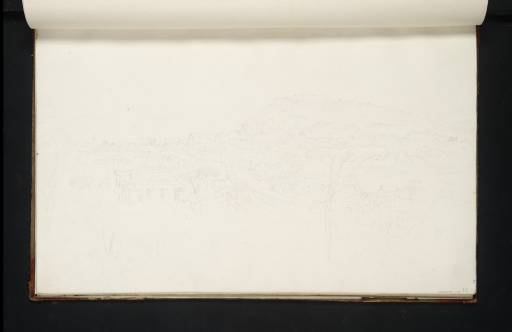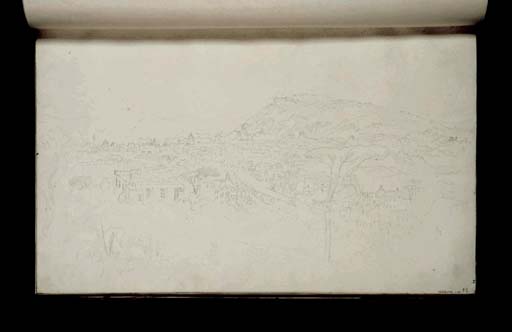Joseph Mallord William Turner Naples from Capodimonte 1819
Image 1 of 2
Joseph Mallord William Turner,
Naples from Capodimonte
1819
Joseph Mallord William Turner 1775–1851
Folio 22 Recto:
Naples from Capodimonte 1819
D16110
Turner Bequest CLXXXVII 22
Turner Bequest CLXXXVII 22
Pencil and traces of watercolour on white wove paper, 255 x 403 mm
Inscribed by the artist in pencil ‘yellw’ within sketch bottom left, and ‘green’ bottom centre right. Also by ?the artist in pencil ‘58’ bottom right
Inscribed by John Ruskin in blue ink ‘22’ bottom right, descending right-hand edge
Stamped in black ‘CLXXXVII 22’ bottom right
Inscribed by the artist in pencil ‘yellw’ within sketch bottom left, and ‘green’ bottom centre right. Also by ?the artist in pencil ‘58’ bottom right
Inscribed by John Ruskin in blue ink ‘22’ bottom right, descending right-hand edge
Stamped in black ‘CLXXXVII 22’ bottom right
Accepted by the nation as part of the Turner Bequest 1856
Exhibition history
1904
National Gallery, London, various dates to at least 1904 (333).
References
1905
E.T. Cook and Alexander Wedderburn (eds.), Library Edition: The Works of John Ruskin: Volume VII: Modern Painters V, London 1905, p.247.
1904
E.T. Cook and Alexander Wedderburn (eds.), Library Edition: The Works of John Ruskin: Volume XIII: Turner: The Harbours of England; Catalogues and Notes, London 1904, no.333, pp.379, 624, as ‘Naples, from the South’.
1906
E.T. Cook and Alexander Wedderburn (eds.), Library Edition: The Works of John Ruskin: Volume XXII: Lectures on Landscape; Michel Angelo & Tintoret; The Eagle’s Nest; Ariadne Florentina; with Notes for Other Oxford Lectures, London 1906, p.29 note 1.
1907
E.T. Cook and Alexander Wedderburn (eds.), Library Edition: The Works of John Ruskin: Volume XXX: The Guild and Museum of St. George: Reports, Catalogues, and Other Papers, London 1907, p.352, under no.35.
1909
A.J. Finberg, A Complete Inventory of the Drawings of the Turner Bequest, London 1909, vol.I, p.556, as ‘Naples from the south. Exhibited Drawings, No.333, N.G.’.
1920
D[ugald] S[utherland] MacColl, National Gallery, Millbank: Catalogue: Turner Collection, London 1920, p.86.
1984
Cecilia Powell, ‘Turner on Classic Ground: His Visits to Central and Southern Italy and Related Paintings and Drawings’, unpublished Ph.D thesis, Courtauld Institute of Art, University of London 1984, p.193, reproduced fig.114, as ‘Naples from inland’.
1987
Cecilia Powell, Turner in the South: Rome, Naples, Florence, New Haven and London 1987, p.[85] note 73, reproduced p.[86] fig.86, as ‘Naples from inland’.
One of the famous vantage points for panoramic vistas of Naples was Capodimonte (the Italian literally translates as ‘Head of the Mountain’), a hill to the north of the city dominated by an eighteenth-century royal palace (the Reggia or Palazzo di Capodimonte), built for the Bourbon King, Charles III. This study depicts the view from the edge of the park surrounding the palace (the Bosco or Parco di Capodimonte) looking south towards distant Capri and the Sorrentine peninsula. Turner has meticulously recorded the topography of the cityscape spread out before him, from the lighthouse of the Mole on the left, to the hill rising on the right, with the fortress of Castel Sant’Elmo and the Certosa (Charterhouse) of San Martino. Visible as a diagonal thoroughfare across the centre of the composition is the Ponte della Sanità viaduct and the new road built at the beginning of the nineteenth century which connects the lower city with Capodimonte (present-day Corso Amedeo di Savoia). Further sketches from Capodimonte can be also be found within this sketchbook, see the verso of the present leaf and folio 23 (D41406, D16111), as well as in the Gandolfo to Naples sketchbook (Tate D15691–D15692; Turner Bequest CLXXXIV 66a–67). As a young man, Turner made a copy with Thomas Girtin of a related prospect by another artist (see Tate D36536; Turner Bequest CCCLXXV 15). He was probably also familiar with a similar view by James Hakewill (1778–1843), dating from the Hakewill’s travels in Italy during 1816–17.1
Unlike the artist’s limpid and evocative Neapolitan watercolours, this detailed pencil composition contains no suggestion of atmospheric effects and is concerned with an accurate description of place. John Ruskin described it as an example of ‘Turner’s fixed manner of sketching throughout life – the utmost possible quantity of information put into the smallest possible space, but always arranged for a perfect picture’.2 He found the study analogous to ‘a map of the scene giving the solid forms instead of the flat spaces; there is no more effort to make you fancy yourself at the place than if he were making a geometrical survey of an estate’.3 He commissioned the artist, William Ward (1829–1908), to make a copy of the drawing for the Ruskin Cabinet at Whitelands College, Chelsea (now part of the Roehampton Institute).4 Ward originally worked in pencil but Ruskin instructed him to reinforce many of the lines in pen and ink, in order to reveal the full complexity of the scene.5
There is another drawing, not recorded by Finberg, on the verso (D41406).
Nicola Moorby
May 2010
See Tony Cubberley and Luke Herrmann, Twilight of the Grand Tour: A Catalogue of the drawings by James Hakewill in the British School at Rome Library, Rome 1992, no.5.40, p.267, reproduced.
How to cite
Nicola Moorby, ‘Naples from Capodimonte 1819 by Joseph Mallord William Turner’, catalogue entry, May 2010, in David Blayney Brown (ed.), J.M.W. Turner: Sketchbooks, Drawings and Watercolours, Tate Research Publication, December 2012, https://www


